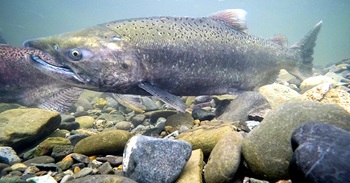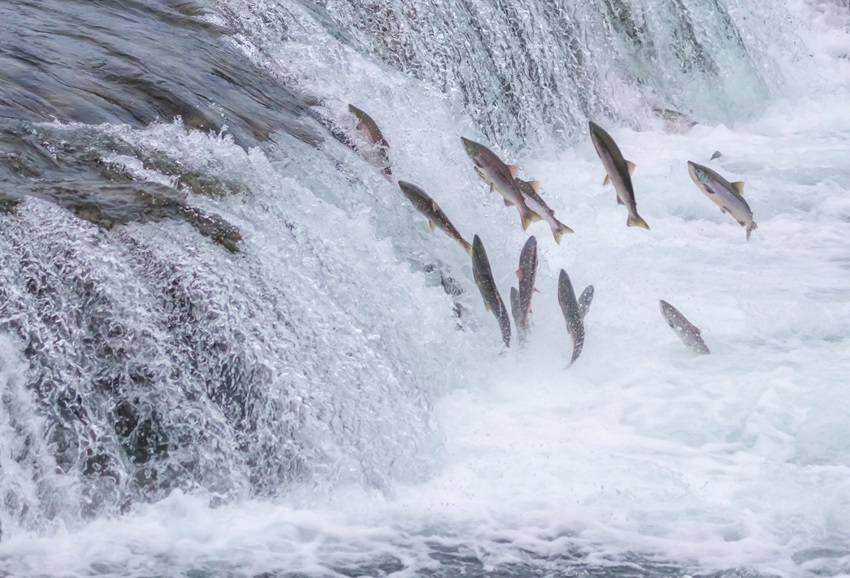State, federal and local agencies are working to advance a transformational, watershed-wide approach to increase river flows, restore ecosystems and strengthen water supply reliability across the state.
The approach -- sometimes referred to as the “Voluntary Agreements” is a comprehensive, multi-year solution that brings together local, state, and federal partners to pool resources and take concrete actions to increase river flows and expand habitat in the Sacramento and San Joaquin Rivers, their tributaries, and the Bay-Delta. Through this approach, California would dedicate a large quantity of water to the environment and restore 45,000 acres of aquatic habitat for fish and other animals. Guided by scientific monitoring and collaborative decision making, this new approach allows water managers to adapt operations based on real-time conditions and enable broad coordination across watersheds to manage flows for maximal benefits.
The agreements, if approved by the State Water Resources Control Board as an implementation pathway for an updated Bay-Delta Plan, would help meet requirements to protect beneficial uses in the Sacramento and San Joaquin watersheds. This approach provides a promising pathway to protect and restore our environment, enable California’s economy to thrive, and provide a foundation for a more resilient future as climate change increases uncertainty and drives extreme conditions. When it comes to water in California, now is the time to bridge our differences in the pursuit of sustainable solutions that meet our state’s needs.
CONTACT INFORMATION For questions regarding this Program, email HealthyRiversandLandscapes@resources.ca.gov. Email HRLpermitting@wildlife.ca.gov to contact the California Department of Fish and Wildlife about permitting for Healthy Rivers and Landscapes projects. You can also sign up to receive periodic program updates, such as our Healthy Rivers and Landscapes Fall newsletter.
 Commitments by participating water agencies generate hundreds of thousands of acre-feet of water dedicated for environmental purposes that will be adaptively managed to benefit native fish populations and habitats and dedicated to Delta outflow. The amount of this environmental water flow varies depending on how dry or wet a year becomes, with over 800,000 acre-feet in some years. Much of this water can be flexibly managed based on timing and season to increase instream flows and Delta outflows, and test biological hypotheses while reducing impacts to water supplies.
Commitments by participating water agencies generate hundreds of thousands of acre-feet of water dedicated for environmental purposes that will be adaptively managed to benefit native fish populations and habitats and dedicated to Delta outflow. The amount of this environmental water flow varies depending on how dry or wet a year becomes, with over 800,000 acre-feet in some years. Much of this water can be flexibly managed based on timing and season to increase instream flows and Delta outflows, and test biological hypotheses while reducing impacts to water supplies.
Commitments by local, state and federal water agencies also restore tens of thousands of acres of aquatic habitat for fish and other animals to thrive. Science is clear that both adequate river flows and habitat are necessary to recover fish populations. Habitat projects are moving forward across California's watersheds.
The program includes a governance program to direct flows and habitat restoration, conduct regular assessments, develop strategic plans and annual reports and implement a robust integrated science program. Flow and habitat measures will be adaptively managed through structured decision making and informed by the science program. The program will be accountable to the State Water Board, which will maintain continuing oversight, assess progress, and ensure the Bay-Delta Plan is being properly implemented.
Tribal Engagement in Agreements to Support Healthy Rivers and Landscapes
California Natural Resources Agency (CNRA), Department of Water Resources (DWR) and Department of Fish and Wildlife (DFW) are committed to Tribal Engagement as part of the implementation of the Agreements to support Healthy Rivers and Landscapes' habitat, flow, and science elements. The Agreements Draft Strategic Plan and Draft Governance Program (Appendix B) recognize the importance of incorporating Tribal perspectives and respecting Tribal sovereignty. Tribal Ecological Knowledge (TEK) is a Best Available Science (2023 Draft California Water Plan Update) and the inclusion of Tribal science in the implemental of these agreements is critical, which is further acknowledged in the Draft Science Plan (Appendix C) and the Science Committee Charter.
Consistent with the Draft Governance Program’s Governance Principles of inclusiveness, collaboration, transparency, accountability to outcomes, consensus-seeking, and informed decision making, the proposed Agreements strongly welcome the involvement of California Tribes. Participating Tribes would have full control regarding the use and disclosure of cultural, traditional, proprietary, TEK, or any other Tribal information they deem sensitive. Further, California Tribes, non-governmental organizations, and other interested parties are eligible for membership in the Systemwide Governance Committee and Science Committee.
Tribal Informational Meetings
CNRA, DWR, and DFW are convening periodic Tribal meetings to provide program updates and maintain opportunities for Tribal engagement. The meetings also present an opportunity for Tribes to discuss their concerns through a state-supported Tribal caucus with a facilitator and note-taker. The first Tribal caucus was held in January, in a separate breakout session exclusively for participating Tribal representatives with state representatives remaining in the main room to answer any questions or provide support upon request. Notes from the Tribal caucus discussion have been provided to state representatives to provide insight and inform future meetings. Information for previous and upcoming meetings are below:
- January 24, 2024: Tribal Governance Meeting #1 [Link to Save the Date]
- March 7, 2024: Tribal Governance Meeting #2 [Link to Save the Date]
- Meetings will continue to be scheduled with information posted here.
The Agreements
The Agreements include up to 825,000 acre-feet of new flows depending on water year type, 7,000 acres of habitat restoration, 40,000 acres of floodplain enhancement and fish food production, 14 fish passage and weir improvement projects, and at least 8 other salmonid habitat enhancement projects. See Draft Strategic Plan, Appendix D for more details and a non-exhaustive list.
Tribal Consultation
The informational meetings are not meant to replace government-to-government consultation. There are individual habitat projects that include a consultation step with local Tribes, and DWR, DFW, and CNRA maintain their commitment to the consultation process for the projects proposed for inclusion in the Agreements to Support Healthy Rivers and Landscapes.
Tribal governments are encouraged to consult directly with DWR and DFW at any time during and each agency is guided by the CNRA Tribal Consultation Policy and individual department policies for Tribal consultation.
The Science Committee
The Science Committee for the proposed Healthy Rivers and Landscapes Program guides the development of this Science Program and oversees its implementation. The Science Committee is an active working group with all members reviewing and producing materials, and all participants have relevant knowledge of the regions or tributaries that they represent. The intent is for the Science Committee to oversee a process of active learning, such that new information can be applied to habitat and flow actions during implementation. Participation in the Science Committee does not require a signature on the MOU.
Additionally, any habitat or flow projects based on traditional and Tribal knowledges would prepare a data sharing agreement that defines how project results and deliverables will be used, in alignment with the CARE data principles (Collective benefit, Authority to control, Responsibility, and Ethics, Carroll et al. 2020). A data management plan would also be developed within the first year of the adoption of the Program and will protect the sovereignty of Tribes and not disclose sensitive or confidential information.
How to Stay Informed and Request Consultation
Department of Water Resources
Anecita Agustinez, Executive Manager
DWR Office of Tribal Affairs
tribalpolicyadvisor@water.ca.gov
Department of Fish and Wildlife
Sarah Fonseca, Tribal Liaison
DFW Office of Tribal Affairs
The agreements create a broad program to implement environmental improvements in many of California's largest rivers and the Bay-Delta estuary into which these rivers flow. Environmental improvements are needed for these rivers and the Bay-Delta to reverse long-term declines in native fish populations. The State Water Board has already commenced an update to its Bay-Delta Plan to improve conditions for native fish and the agreements provide a pathway to achieve these ends and to reasonably protect beneficial uses in these rivers as required by state law.
The agreements encompass a set of binding commitments by water agencies and state and federal government to improve environmental conditions over the next eight years. These actions will be monitored for effectiveness over time and adapted based on scientific monitoring and changing conditions.
Through the agreements, significant, coordinated investments will be made to improve fish and wildlife habitat conditions throughout the watershed. The agreements encompass more than 45,000 acres of instream habitat, new spawning and rearing habitat, floodplain habitat and fish food production. Many identified environmental improve projects can be implemented in the next 12-18 months – injecting tens of millions of dollars into the state’s economy through habitat restoration projects.
The Approach Includes:

Resources
- Healthy Rivers and Landscapes Newsletters
- Frequently Asked Questions
- MOU
- Recent Public Announcements
- Science
- Draft Strategic Plan and Other Program Materials
- Governance
- Global Agreement
-



























